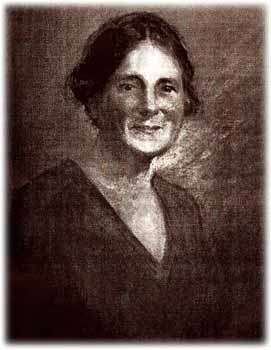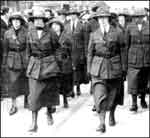
|
|
||
  She became part of a circle of revolutionary Republicans, forming deep bonds with the Socialist leader James Connolly and the wildly flamboyant Countess Marchievicz. Their dream was to free Ireland of British rule and with it all forms of oppression, be it based on gender, social or religious bios. It was a notion that Kathleen Lynn carried with her for the rest of her life. When Connolly formed the Irish Citizen Army (ICA) in 1913 he elected Kathleen to be the Chief Medical Officer, and for the next few years she provided medical training to recruits of the ICA and was active in the smuggling of arms in preparation for the uprising.  The Easter Rising, though a disaster in itself, sparked an enormous resurgence in Irish Nationalism and on her return from exile Kathleen joined Sinn Fein, the political party led by Arthur Griffith, which now served as an umbrella for all wings of the nationalist cause. It was through this that Kathleen and her long time lover Madeline ffrench Mullen came to form St. Ultan's Hospital for infants. At the time World War 1 was drawing to a close and Ireland was preparing for an estimated 15,000 soldiers to return from the country infected with syphilis. Kathleen led a national campaign to have the soldiers tested before re-entry but as this was a disease that was only likely to infect the prostitutes of Dublin's slums, the British authorities refused to take any action. It was in response to this, that the decision was made to start a hospital dedicated to helping the syphilitic babies, born diseased as a result of negligence by an unwelcome ruler. Despite all this Kathleen was arrested again and threatened with deportation, but by this time a new scourge had hit Dublin, one that was not limited to the working classes. It was called the Spanish Flu, and in a few short months took the lives of more than 18,000 people in the city. Streets were lined with dead bodies, hundreds lay in open graves awaiting burial, and doctors were in chronic short supply. Dublin's Lord Mayor headed the petition to save Kathleen from deportation, calling her "innocent as a new born babe." Her family too, despite their disgust at her political standpoint, joined in the drive to save her from imprisonment. In the end Kathleen made a promise to King and Country, never to involve herself in politics again in return for her freedom. Needless to say, she never kept that promise. Once the flu began to subside, the hospital returned its energies to that of saving the lives of young babies and the business of staffing the hospital got underway. The team she hired was almost exclusively female, with only visiting consultants being men. Gender was not the only common denominator; most of the nursing staff and many of the doctors were known Republican activists. The treaty between Ireland and Britain fell far short of Kathleen's aspirations because it divided North and South, providing a new free state with only 26 counties instead of the entire 32. The nationalist contingent was split over the issue, giving rise to a bitter, violent, civil war that was to last several years. Despite her involvement with the war, Kathleen was essentially a deeply religious woman with a hatred of bloodshed and possessed of a genuine desire for lasting peace. Far into the war, at a point when up to 25,000 male and female anti treaty citizens were imprisoned under horrendous conditions, Kathleen was a leader in the organisation of major prayer rallies, designed to bring the war to an end. In 1929, Kathleen and St. Ultan's founded the world famous Irish Sweepstakes alongside three other voluntary hospitals. However the new source of revenue prompted the Government to halt all forms of State support. When the Sweepstake fund reached £2 million the State insisted on all monies to be directed through a Government account. By 1943, the State had officially sequestered all the Sweepstake funds using all of them to support their own schemes. In January 1935, Kathleen and St. Ultan's began pursuing an amalgamation with another children's hospital with the aim of becoming the National Children's hospital. The process was begun with enthusiasm but gradually opposition appeared and one by one the members turned against the idea. It was not until August of that year that Kathleen realised that the Catholic Church were behind the problem with the infamous Archbishop McQuaid at the helm. In the wider scheme of things, McQuaid and his Catholic position was taking its toll amongst all the voluntary bodies, especially those run by non-Catholics. Mysteriously, Dublin Corporation withdrew its support from organisations running charity food halls as well as hospitals. More than thirty Dublin organisations were in the same boat, and the new situation ensured that the extension to St. Ultan's was never built. In the early '40s St. Ultan's began a plan to bring a new vaccination for tuberculosis into Ireland and to build a new unit on their grounds to implement it. The Hospital Commission flatly refused to fund the project despite the fact that the disease was killing 4,000 people every year in the country. Kathleen overcame this by raising the funds from private sources and Dublin Corporation finally relented some small relief by providing a small sum towards building the extension. The following month St. Ultan's got yet another shock that was to have far reaching consequences. They received an official order from the Ministry of Health not to take any Gas Enteritis cases. This was very significant because apart from TB, Gas Enteritis was the main illness treated at St. Ultan's at that time. The TB unit finally opened in May 1945 but all felt very aware of the threat to survival caused by various methods within Government bodies. The battle continued in the effort to bring the TB vaccine BCG into the country. The brilliant Dr. Dorothy Price, who by now has earned an international reputation for the treatment of TB, headed the campaign. St. Ultan's had two major obstacles to overcome, firstly to obtain the license from Sweden to use the vaccine and secondly to get the government's support on the matter. Despite the high death rate from TB, the government was extremely reticent about its treatment and came out publicly in the autumn of 1946 saying that St. Ultan's proposed BCG scheme was unnecessary. Whether their position came from the camp that wanted St. Ultan's closed down or if it was because they genuinely didn't see TB as a problem has yet to be researched. By 1949, St. Ultan's were finally granted the license to issue the BCG vaccine. Kathleen went to visit the Minister for Health, Noel Browne, to try and enlist his support on the issue. He gave permission for them to go ahead but insisted that they take full responsibility for its distribution and he also demanded that they were also financially oblige to sponsor it. It was only a matter of days following this meeting that the minister publicly announced his new BCG scheme, a move obviously designed to take credit for St. Ultan's efforts. Kathleen and the hospital made no moves to point this out; they were not in a position to do so. On the 20th May 1949, Noel Brown opened the new unit. The scheme proved to be a total success and was the first step toward the total eradication of TB in Ireland. Interestingly, Noel Browne failed to mention St. Ultan's role with regard to the BCG in his autobiography. The BCG unit continued well for the next few years and received very good publicity for the hospital and in June 1953, their success was evident when the British Minister for Health visited the unit. However, controversy raised its head once again in 1953, when the government sent a letter ordering the BCG unit to be closed down. The move caused a public outcry and the Government claimed that the whole thing was a misunderstanding. The unit was reopened however and the Government continued to cause problems for them by withholding the finance. Dr. Kathleen Lynn died in 1955 of old age. She was as controversial in death as she was in life, her presence a reminder of the sharp divides within the Irish State. At her funeral, the presiding minister called her a mean woman, whilst her former friend and foe, Eamonn DeValera stood outside to pay his last respects, he risked excommunication if he entered the Protestant Church. She was given a full military funeral but it is doubtful that she would have wanted it. She was so disgusted with the new Ireland that she never bothered attending celebrations the day Ireland officially became a republic in 1949. In an ironic twist it was Eamonn DeValera who set up the "Kathleen Lynn Memorial Committee" which ran for eight years. Its result was a new £7000 surgical unit opened in St. Ultan's Hospital on November 1964 by the then Minister for Health Mr. Sean MacEntee. The President, Mr Eamonn DeValera sat in the audience. St. Ultan's closed its doors for the last time in 1975, difficulties in getting funding made it impossible to continue. It is now a private clinic. |


